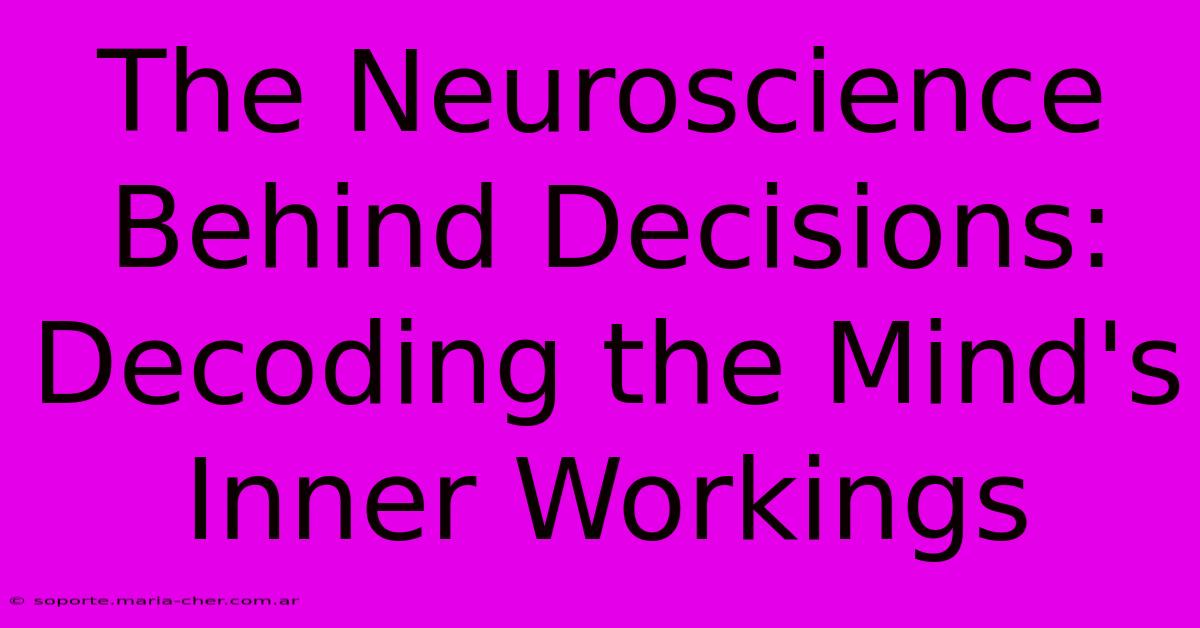The Neuroscience Behind Decisions: Decoding The Mind's Inner Workings

Table of Contents
The Neuroscience Behind Decisions: Decoding the Mind's Inner Workings
Our daily lives are a continuous stream of decisions, from mundane choices like what to eat for breakfast to life-altering decisions about careers and relationships. But what's actually happening inside our brains when we make these choices? Understanding the neuroscience behind decisions reveals a fascinating interplay of brain regions, neurochemicals, and cognitive processes. This exploration delves into the intricate workings of the mind, illuminating how we weigh options, assess risks, and ultimately, arrive at a decision.
The Brain's Decision-Making Network
The decision-making process isn't localized to a single brain region; rather, it's a complex, distributed network involving several key players:
1. The Prefrontal Cortex (PFC): The Executive Control Center
The PFC is often dubbed the "executive control center" of the brain. It plays a crucial role in:
- Working Memory: Holding information relevant to the decision at hand.
- Inhibition: Suppressing irrelevant information and impulsive responses.
- Planning: Formulating strategies and anticipating outcomes.
- Decision-making: Integrating information from other brain regions to guide choices.
Damage to the PFC can significantly impair decision-making abilities, leading to impulsive behavior and poor judgment.
2. The Amygdala: The Emotion Center
The amygdala is the brain's emotional hub, processing feelings like fear, anxiety, and reward. Its influence on decision-making is profound:
- Emotional Biases: The amygdala can inject emotional weight into decisions, sometimes overriding rational considerations. This is evident in situations involving fear or strong emotional attachments.
- Risk Assessment: It helps assess potential risks and rewards associated with different options. A highly active amygdala might lead to risk-averse decisions, while a less active one might result in risk-seeking behavior.
3. The Nucleus Accumbens: The Reward System
The nucleus accumbens is a key component of the brain's reward system, releasing dopamine in response to pleasurable experiences. This neurotransmitter plays a vital role in:
- Reinforcement Learning: We learn to repeat decisions that lead to positive outcomes (reward) and avoid those leading to negative ones (punishment). Dopamine reinforces these learned associations.
- Motivation: The anticipation of reward motivates us to make decisions that will lead to that desired outcome.
4. The Hippocampus: Memory and Context
The hippocampus is crucial for memory consolidation and retrieval. Its role in decision-making is less direct but equally important:
- Past Experiences: Our past experiences, stored in the hippocampus, heavily influence our current decisions. We draw on memories to predict outcomes and inform our choices.
- Contextual Information: The hippocampus helps us understand the context of a decision, allowing us to adapt our strategies accordingly.
Neurochemicals and Decision-Making
The interplay of various neurochemicals significantly shapes our decisions:
- Dopamine: As mentioned earlier, it plays a pivotal role in reward-based learning and motivation.
- Serotonin: Influences mood and impulsivity. Low serotonin levels are often associated with impulsive decision-making.
- Norepinephrine: Enhances alertness and focus, impacting our ability to process information effectively during decision-making.
- Acetylcholine: Crucial for memory and attention, supporting the cognitive processes involved in weighing options.
Factors Influencing Decisions
Beyond the neural circuitry, several external factors influence our choices:
- Cognitive Biases: Systematic errors in thinking that can lead to irrational decisions. Examples include confirmation bias (favoring information that confirms pre-existing beliefs) and anchoring bias (over-relying on the first piece of information received).
- Social Influences: Our decisions are often shaped by social pressures and the opinions of others.
- Environmental Factors: Contextual cues and environmental stimuli can unconsciously influence our choices.
Conclusion: A Complex Interplay
Understanding the neuroscience behind decisions reveals a complex interplay of brain regions, neurochemicals, and cognitive processes. It's not simply a matter of rational calculation; emotions, memories, and external influences all play significant roles. Further research in this field promises to shed more light on the intricacies of human decision-making, leading to advancements in fields like neuroscience, psychology, and even artificial intelligence. By gaining a deeper understanding of how our brains make decisions, we can better navigate our lives and improve our decision-making skills.

Thank you for visiting our website wich cover about The Neuroscience Behind Decisions: Decoding The Mind's Inner Workings. We hope the information provided has been useful to you. Feel free to contact us if you have any questions or need further assistance. See you next time and dont miss to bookmark.
Featured Posts
-
Bondi Confirmed As Attorney General Senate Vote
Feb 05, 2025
-
From Saint Nick To Your Canvas The Png Trail To Christmas Splendor
Feb 05, 2025
-
Houstons Most Influential Architecture Firm Perry Homes Hq Exposed
Feb 05, 2025
-
Unveiled The Inner Sanctum Of Houstons Architectural Marvel
Feb 05, 2025
-
Elevate Your Gift Giving Custom Gift Tags For Unforgettable Moments
Feb 05, 2025
